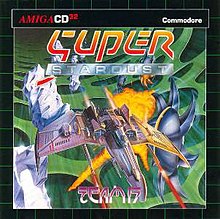
Zool: Ninja of the Nth Dimension is a platform video game developed and published by Gremlin Graphics. It was marketed as a rival to Sega's Sonic the Hedgehog. Originally released for the Amiga home computer in October 1992, the game was subsequently ported to Sega Genesis, Super Nintendo Entertainment System, Master System, Game Boy and Game Gear, as well as other home computers. A sequel, Zool 2, was released in 1993. A remastered version of the original game, titled Zool Redimensioned, was developed by Sumo Digital Academy and published by Secret Mode for Windows, PlayStation 4 and Xbox One in August 2021.

The Chaos Engine is a top-down run and gun video game developed by The Bitmap Brothers and published by Renegade Software in March 1993. The game is set in a steampunk Victorian age in which one or two players must battle the hostile creations of the eponymous Chaos Engine across four landscapes and ultimately defeat it and its deranged inventor.

Zool 2 is a side-scrolling platform video game originally developed by The Warp Factory and published by Gremlin Graphics for the Amiga in November 1993. It is the sequel to the original Zool, which was released earlier in 1992 on various platforms.
The fifth generation era refers to computer and video games, video game consoles, and handheld gaming consoles dating from approximately October 4, 1993, to March 23, 2006. The best-selling home console was the Sony PlayStation, followed by the Nintendo 64, Sega Saturn, and Atari Jaguar. The PlayStation also had a redesigned version, the PSone, which was launched on July 7, 2000.
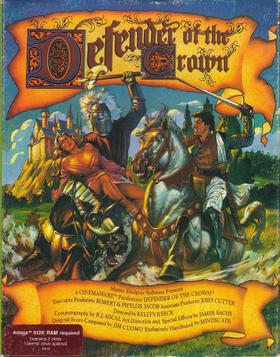
Defender of the Crown is a strategy video game designed by Kellyn Beeck. It was Cinemaware's first game, and was originally released for the Commodore Amiga in 1986, setting a new standard for graphic quality in home computer games.

Pinball Fantasies is a 1992 pinball video game originally developed by Digital Illusions and published by 21st Century Entertainment in Europe for the Amiga home computers. It is the sequel to Pinball Dreams, which was released earlier in the same year on multiple platforms. In the game, players can choose between any of the four available playfields, both of which have their own thematic and main objectives in order to obtain the highest score possible.

Stardust is a 1993 multidirectional shooter video game developed and published by Bloodhouse for the Amiga. The game is an Asteroids clone with enhancements, such as power-ups, shields, a high-energy techno module soundtrack, vivid use of colors and the occasional tunnel section that revolves around a sphere. The game's graphics drew critical acclaim for the aforementioned tunnels and the liberal use of ray-tracing. The company has since merged with Terramarque to form Housemarque.

Soccer Kid is a 1993 side-scrolling platform game developed and published by Krisalis Software in Europe for the Amiga. The player assumes the role of the titular main protagonist who travels across several countries around the world to repair the World Cup by retrieving pieces that were scattered by the alien pirate Scab, the main antagonist who failed to steal and add it to his trophy collection in a robbery attempt. Its gameplay mainly consists of platforming and exploration elements, with a main single-button or two-button configuration, depending on the controls setup.

Syndicate is an isometric real-time tactical and strategic game from Bullfrog Productions created in 1993, and released for a variety of platforms beginning with the PC and Commodore Amiga. It is the first title in the Syndicate series. Set in a dystopian future in which corporations have replaced governments, Syndicate puts the player in control of a corporation vying for global dominance.
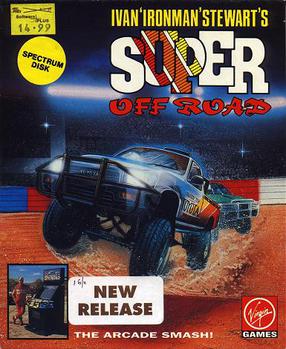
Ivan 'Ironman' Stewart's Super Off Road is an arcade video game released in 1989 by Leland Corporation. The game was designed and managed by John Morgan who was also lead programmer, and endorsed by professional off-road racer Ivan Stewart. Virgin Games produced several home versions in 1990. In 1991, a home console version for the Nintendo Entertainment System was later released by Leland's Tradewest subsidiary, followed by versions for most major home formats including the Master System, Genesis, Super NES, Amiga, and MS-DOS. A port for the Atari Jaguar was announced but never released. Some of the ports removed Ivan Stewart's name from the title due to licensing issues and are known simply as Super Off Road.

Jungle Strike is a video game developed and published by Electronic Arts in 1993 for the Sega Genesis. The game was later released on several other consoles such as the Super Nintendo Entertainment System (SNES), and an upgraded version was made for DOS computers. The Amiga conversion was the responsibility of Ocean Software while the SNES and PC DOS versions were that of Gremlin Interactive, and the portable console versions were of Black Pearl Software. It is the direct sequel to Desert Strike and is the second installment in the Strike series. The game is a helicopter-based shoot 'em up, mixing action and strategy. The plot concerns two villains intent on destroying Washington, D.C. The player must use the helicopter and occasionally other vehicles to thwart their plans.

Alfred Chicken is a platform video game developed by Twilight and published by Mindscape. The game was released for Amiga, Amiga CD32, Game Boy, NES, Super NES in 1993 and February 1994, in Europe and North America, respectively. A Europe-exclusive remake of the game, entitled Alfred's Adventure, was developed by Möbius Entertainment and released by SCi for Game Boy Color in June 2000. Another remake, named Alfred Chicken, was also developed by King Monkey, a division of Möbius Entertainment, and released by Sony Computer Entertainment for PlayStation in 2002. Rockstar Games does not own the title's rights, despite buying Möbius later on, as Jason McGann personally held the rights.

Wing Commander is the first game in Chris Roberts' space flight simulation Wing Commander franchise by Origin Systems. The game was first released for MS-DOS on September 26, 1990, and was later ported to the Amiga, CD32 (256-color), Sega CD and the Super Nintendo Entertainment System, and re-released for the PC as Wing Commander I in 1994. An enhanced remake Super Wing Commander was made for the 3DO in 1994, and later ported to the Macintosh.

Alien Breed 3D is a first-person shooter developed for Amiga by Team17 and distributed by Ocean Software in 1995. It is the fourth installment in Alien Breed franchise, a series of science fiction-themed shooters.

Worms is a 2D artillery tactical video game developed by Team17 and released in 1995. It is the first game in the Worms series of video games. It is a turn based game where a player controls a team of worms against other teams of worms that are controlled by a computer or human opponent. The aim is to use various weapons to kill the worms on the other teams and have the last surviving worm(s).

Mr. Nutz: Hoppin' Mad is a side-scrolling platform game developed by German team Neon Studios and published by Ocean Software for the Amiga in 1994. The player controls Mr. Nutz, an anthropomorphic red squirrel wearing shoes, gloves and a cap, who must stop chickens from outer space that are trying to take over the world.
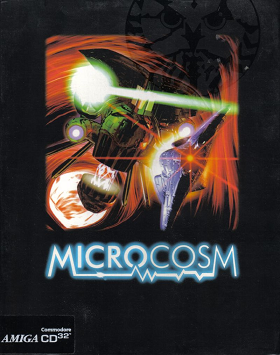
Microcosm is a 3D rail shooter video game developed and published by Psygnosis in 1993. It was originally developed for the FM Towns, and ported for the Sega CD, Amiga CD32, 3DO, and MS-DOS. Microcosm featured realistic FMV animation, with the graphics being rendered on Silicon Graphics workstations. The game is either in first-person or third-person view depending on the gaming system.

The Amiga CD32 (stylized as Amiga CD32) is a home video game console developed by Commodore as part of the Amiga line, as well as the final hardware to be developed by the company. Released in September 1993 in Europe, Australia, Canada, and Brazil, it was marketed as the "first" 32-bit games console and is essentially a keyboard-less Amiga 1200 personal computer without the I/O ports, but with the addition of a CD-ROM drive in place of floppy and a modified Advanced Graphics Architecture chipset for improved graphical performance.
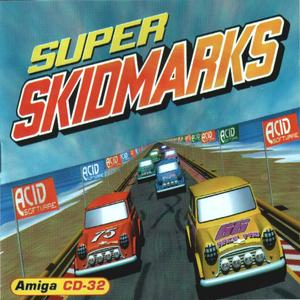
Super Skidmarks is a racing video game developed by Acid Software and released in 1995. The game is the sequel to Skidmarks and as such was also termed Skidmarks 2 and Super Skidmarks 2 by commentators. The game features “minimally realistic” action viewed from an isometric perspective as well as novelty vehicles such as wheeled cows and caravans. Various methods such as joypad adapters and link systems are employed to allow multiple players to compete, up to a maximum of 8. The game was critically acclaimed and a best-seller in the UK. Several upgrades to the Amiga original were released as well as conversions for the Amiga CD32 and Sega Mega Drive, the latter published by Codemasters.

Brutal Sports Football is a 1993 sports video game developed by Teque London and originally published by Millennium Interactive for the Amiga. It was re-published for MS-DOS and Amiga CD32, and later became the first third-party title published for the Atari Jaguar. The first entry in the Brutal Sports series, the game is a fictional style of football played against human or computer-controlled opponents. It features a different take on american football by emphasising the violent aspect of the sport.
